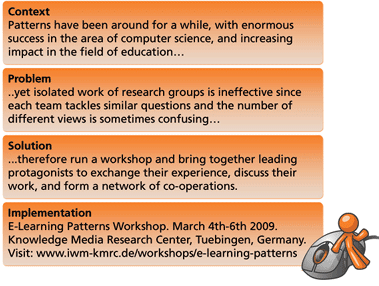 Home | Call for Abstracts | Registration | Program Design Patterns as Guidance for Designers of Groupware Used by Team for the Development of Innovative Products
Development of innovative products requires people with various skills and know-how to collaborate in multidisciplinary teams and learn from each other. Nowadays, these teams more and more work distributed across locations. This implies that collaborative work and creativity should be facilitated by usable groupware systems (Strijbos, et al. 2004). Designing effective groupware systems is a complex task which requires the synergy of several people of different specialties and expertise. Designers (particularly novice ones) need guidance and advices to help them produce effective prototypes. On the one hand guidance and advice need to be based on solid research and empirical findings. On the other hand, they should not be is too prescriptive, or based on a single model, since they won’t help designers to create innovative prototypes, suited to their particular context, and benefited from the most of new and evolving technology. In the specific domain of collaborative development of innovative products, which is the focus of our work in the idSpace project (http://idspace-project.org), groupware system designers need to cooperate with experts who knows about creativity, innovative products development processes and computer supported collaborative work-based learning, as well as with application domain specialists who will incorporate the system into their working environment (e.g. airospace industry). As an effect there is a need for a common design language. In general, people within a discipline often have trouble communicating their ideas and decisions to other specialists (Borchers, 2001). One of the challenges in groupware system design is to develop effective techniques for making specialists’ knowledge and assumptions more explicit, and easier for the other disciplines to understand and refer to. Design patterns (DPs) could play the role of a “lingua franca” thus supporting discussions among people who are specialists in various disciplines (Fincher , 1999). DPs express the accumulated & tacit design knowledge with respect to a specific problem either pedagogical or technical or organizational and propose how this problem can be solved when someone deals with it. Therefore, in the context of creativity process and collaborative innovative product development DPs are expected to reduce the conceptual gap among the fields of collaborative work, innovation design, creativity process and the software development world. In this paper we
propose one DP about the Six Hats creativity technique which can help
the designing team to create a groupware system for supporting it. The
DP acts as a medium for transferring the design knowledge of creativity
experts to the groupware system designers and evaluators. The DP can
tackle or highlight different insights of creativity for collaborative
design, i.e. cognitive, psychological and organizational ones. The proposed
DP is a flow design pattern (FDP) which should be regarded as a more
formal way of describing the Six Hats creativity technique. The term
“flow” refers to the coordination at activity level (activity-level
coordination), which describes the sequencing of activities that make
up a process . The structure of
the paper is as follows: The first section describes the process of
the innovative product development and the need to support it by groupware
systems. Section 2 presents the notion of flow design patterns for creativity
techniques. Section 3 discuses via an example how the design pattern
can help the designers of a groupware system to facilitate the collaborative
creativity process. Section 4 contains concluding remarks about the
use of design patterns for supporting the design process of groupware
systems. References
|
|

